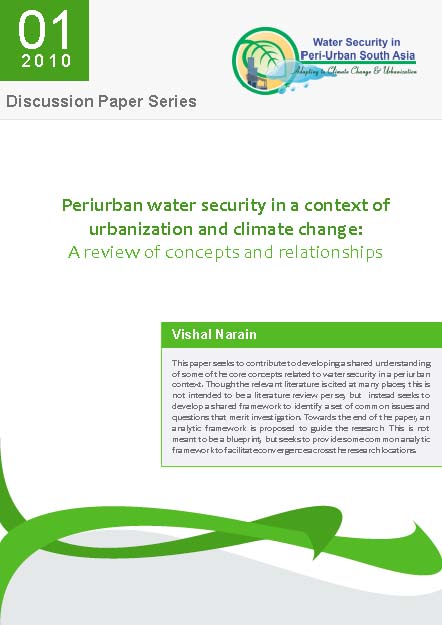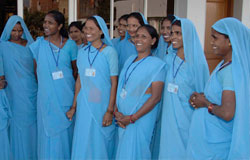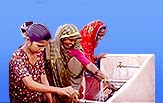Rural Water
Peri-urban water security in a context of urbanization and climate change - A review of concepts and relationships by SaciWaters
Posted on 17 May, 2011 04:05 PM
It is a part of the peri-urban water security project discussion paper series that aims at having a collection of research papers relevant to the concepts and processes involved in the project that represent preliminary ideas circulated to encourage discussion and comments.
Though the relevant literature is cited at many places, this is not intended to be a literature review per se, but instead seeks to develop a shared framework to identify a set of common issues and questions that merit investigation.
The paper argues that peri-urban can be better understood in terms of its characteristics - a mix of agricultural and non-agricultural land uses, flows of goods, services and resources between villages and urban centers and a social profile that is very heterogeneous and in a state of flux. All these impact upon the local natural resource base, creating particular environmental and natural resource management problems that are often beyond the scope of urban or rural governments alone and require innovative ways of being addressed.
NREGA and rural water management in India: Improving the welfare effects – An occasional paper by IRAP
Posted on 09 May, 2011 09:41 PMNREGA is being eulogized by many in the academic, development and policy arena as a “silver bullet” for eradicating rural poverty and unemployment, by way of generating demand for productive labour force in villages and private incentives for management of common property resources.
Gender-sensitive sustainable sanitation - Women s groups in Chhattisgarh take initiative to bring toilets into their households and sustainable sanitation into their communities - ADB case study
Posted on 09 May, 2011 03:06 PM

Sanitation in Women’s Hands
Women in the villages of Chhattisgarh, India have banded together to bring some decent sanitation facilities in their homes—something which has been missing in their lives for a very long time.
Between the city and the salty sea - The wells of Bhuigaon, Thane, Greater Mumbai - Guest post by MS Gopal
Posted on 22 Apr, 2011 05:57 PMAs the concrete jungle of Greater Mumbai reaches Bhuigaon and overuse of groundwater sucks in the sea water, the traditional wells are under threat.
Assessing acute Gastroenteritis risks associated with water quality and sanitation in Hyderabad city - A paper by the Institute of Health Systems (IHS)
Posted on 19 Apr, 2011 11:35 PMThe quality of drinking water is a vital element of public health and well-being. The most effective means of consistently ensuring the safety of a drinking-water supply is through the use of a comprehensive risk assessment and risk management approach that encompasses all steps in water supply from catchment to consumer.
WHO guidelines on water quality term these approaches as water safety plans (WSPs), developed to organize, systematize and apply management practices in drinking-water quality.
Operation and maintenance for rural water supplies – A manual by Department of Drinking Water and Sanitation and the Water and Sanitation Program of World Bank
Posted on 17 Apr, 2011 07:23 AM This Operation and Maintenance (O&M) manual for rural water supplies by the Department of Drinking Water And Sanitation and Water and Sanitation Program of the World Bank complements their Gram Panchayat Handbook released in 2010 . It takes into account the current aspirations and challenges facing the sector, and builds on the framework already set out in the National Rajiv Gandhi Drinking Water Programme (NRDWP) and Strategic Plan 2011-2022.
This Operation and Maintenance (O&M) manual for rural water supplies by the Department of Drinking Water And Sanitation and Water and Sanitation Program of the World Bank complements their Gram Panchayat Handbook released in 2010 . It takes into account the current aspirations and challenges facing the sector, and builds on the framework already set out in the National Rajiv Gandhi Drinking Water Programme (NRDWP) and Strategic Plan 2011-2022.
MoRD announces relaxation in NRDWP guidelines: Sustainability component to be reduced to 10% for 2010-11 and 2011-12
Posted on 14 Apr, 2011 05:54 PMThe MoRD has through this order, announced that this will be relaxed to 10% NRDWP funds, on a 100% Central share basis for all States.
This relaxation would be valid for 2010 – 11 and 2011 – 12. The balance 10% of NRDWP funds that will become available is to be spent on coverage of quality affected and / or non – quality affected habitations, on a 50:50 sharing basis.
Realisation of the fundamental right to water in rural areas: Implications of the evolving policy framework for drinking water – An article by Philippe Cullet in Economic and Political Weekly
Posted on 13 Apr, 2011 10:20 AMThe fundamental right to water in rural areas is well-established in India, but the actual content of this right has not been elaborated upon in judicial decisions. There is no general drinking water legislation that would provide this missing content.
New policy framework for rural drinking water supply: Swajaldhara guidelines – An article by Philippe Cullet in Economic and Political Weekly
Posted on 11 Apr, 2011 07:09 PMIt examines its evolution from the 1970s onwards and focuses, in particular, on the reforms of the past decade, looking more specifically at the Swajaldhara Guidelines. These reforms are of capital importance because they seek to completely change the rural drinking water supply policy framework.
Water pollution in villages - A post in Hindi by Ram Naresh Kumar and Sanjay Singh
Posted on 05 Apr, 2011 02:49 PMगांवों में जल प्रदुषण





